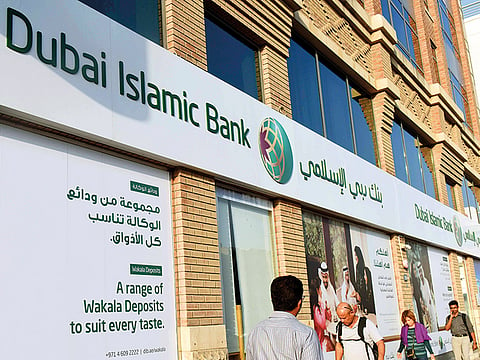Q1 results point to strong start for UAE lenders
Better margins, lower provisions lift performance by lenders

Dubai: Contrary to the expectations that the implementation of International Financial Reporting Standards 9 (IFRS 9) and the introduction of 5 per cent value-added tax (VAT) would have some impact on the profitability of UAE banks, early bank results indicate a strong outlook for the sector.
Leading UAE banks that have reported that their first-quarter results show a steady improvement in interest margins, as well as a decline provisions and improved cost of risk.
According to an analysis of fourth-quarter financial data by Moody’s, First Abu Dhabi Bank (FAB), Emirates NBD, Abu Dhabi Commercial Bank (ADCB) and Dubai Islamic Bank (DIB) — the four leading banks that account for around 62 per cent of banking assets — reported a 7 per cent year-on-year combined increase in profitability in the fourth quarter.
Emirates NBD reported a 15 per cent year-on-year gain in full-year profits while DIB reported an 11 per cent gain.
While FAB reported a 3 per cent decline in profits, attributed to merger costs, ADCB reported 3 per cent higher profits.
“The four largest UAE banks delivered a solid rise in net profits in the final quarter of 2017. This was largely driven by higher business volumes and recent interest rates hikes, which generated higher recurring income, both in the form of net interest income and fees and commissions,” said Nitish Bhojnagarwala, a vice-president at Moody’s.
Clearly, the early results indicate that banks are maintaining the momentum. Emirates NBD reported a net profit of Dh2.4 billion for the first quarter of 2018, up 27 per cent year-on-year and 10 per cent compared to the previous quarter.
Total income improved 13 per cent year-on-year to Dh4.1 billion due to loan growth and the positive impact of recent rate rises. Net interest margin improved by 17 basis points (bps) to 2.68 per cent in the first quarter of 2018, up from 2.51 per cent in first quarter 2017 and helped by rate rises and stable funding costs.
Net interest income improved 7 per cent over the previous quarter due to loan growth coupled with an improvement in margins. Core gross fee income was flat quarter-on-quarter and improved 4 per cent year-on-year on account of higher fee income.
“The group’s balance sheet remains strong with solid liquidity and capital ratios and a further strengthening in credit quality,” said Shayne Nelson, Emirates NBD group chief executive officer.
Dubai Islamic Bank (DIB) Group, the largest Islamic bank in the country, reported a first-quarter net profit Dh1.21 billion, up 16 per cent on the Dh1 billion reported in the same period last year.
The bank’s profitability improved further in the quarter, with total income rising to Dh2.69 billion, compared to Dh2.37 billion for the same period in 2017.
“The year has once again started on a strong note, with 16 per cent profitability growth clearly signifying that the plans put in place continue to yield strong returns,” Dr Adnan Chilwan, Dubai Islamic Bank group CEO, said.
Emirates Islamic, an Islamic bank within the Emirates NBD Group, reported a net profit of Dh209 million for the first quarter of 2018, up 6 per cent year-on-year, supported by growth in core income, efficient cost management and an improved cost of risk.
The bank’s balance sheet remains strong, with improvements seen in credit quality and liquidity.
“An enhanced collection drive and reduced cost of risk resulted in 24 per cent lower impairments as compared to the same period last year,” said Jamal Bin Galaita, CEO of Emirates Islamic.
Strong fundamentals support outlook
Dubai: An improving operating environment linked to a recovery in economic growth, higher interest rates and a modest pick-up in credit growth are expected to boost profitability of the UAE banks in 2018.
UAE Central Bank data for February shows solid credit growth, with gross credit growth expanding by 0.5 per cent month-on-month in February after seeing a growth of the same magnitude in the previous month. This is a significant improvement compared to the slow loan growth witnessed in the fourth quarter of 2017.
Yearly credit growth strengthened gradually to 2.1 per cent year-on-year in February, up from 1.7 per cent in December 2017, with monthly rises in the second month of 2018.
Both the private and government sectors drove credit growth in February, with the two sectors expanding by 0.4 per cent month-on-month and 1.3 per cent month-on-month, respectively.
Private sector credit growth was driven by the corporate sector (0.6 per cent) whilst retail credit growth contracted by 0.1 per cent.
Banks in the UAE are well regulated and supervised and remain well positioned to weather any worsening of credit quality.
Banks remain adequately capitalised with a 17.1 per cent Tier-1 ratio in December 2017, while the ratio of non-performing loans to total loans remains modest around 5 per cent.
The loans to deposit ratio declined slightly in recent months to 99 per cent in February 2018.
Net interest margins have improved since mid-2017, with loans resetting at higher rates and funding costs improving on easing liquidity conditions.
“We expect a rising interest rate environment to be eventually supportive of sector profitability,” said Garbis Iradian, head of Mena research at the Institute of International Finance (IFF). “We expect a modest acceleration in growth in deposits and credit to around 4 per cent by end-2018.”
Sign up for the Daily Briefing
Get the latest news and updates straight to your inbox



